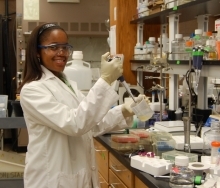
University:
Jackson State University
Major:
Chemistry
Mentor(s):
Anh Vu
Faculty Sponsor(s):
Professor Frederick Dahlquist
Faculty Sponsor's Department(s):
Chemistry and Biochemistry
Project Title:
USING MUTAGENESIS TO ASSIST IN NMR ASSIGNMENT OF A CHEMOTAXIS RECEPTOR
Project Description:
Bacteria such as salmonella and Escherichia coli have impacted the lives of many Americans. These bacteria direct their movements by using their chemotaxis systems. This system helps bacteria to direct their movements based on chemicals in their environment. Unfortunately, it is unclear how chemotactic systems work. For that reason, our laboratory performs interaction studies between proteins inside the chemotactic bacterial cells to understand how these bacterium use chemotaxis to move to a better environment. Research is being conducted to study the relationship between the receptor, CheW, and CheA proteins. In our experiment, we used mutagenesis to assign the NMR peak of the receptor. We made several mutants in the receptor using a polymerase chain reaction and we got two successful mutants that were well behaved and expressed well in the cell. They were (valine) V171A and (isoleucine) I156L. I chose V171A to do further NMR analysis and this protein was purified using a Nickel-NTA column. Results showed that, in contrast to the initial NMR analysis for the wildtype receptor, two peaks disappeared from the NMR methyl spectrum which meant the two peaks must belong to the (valine) V171 residue. Mutagenesis experiments enabled us to label the remaining residues of the receptor protein, thus, making it possible for interaction studies between the receptor, CheW, and CheA proteins. We hope that this data provides new insights to the understanding of the Chemotaxis system and the discovery of new methods to inhibit the mobility of chemotactic bacteria.
